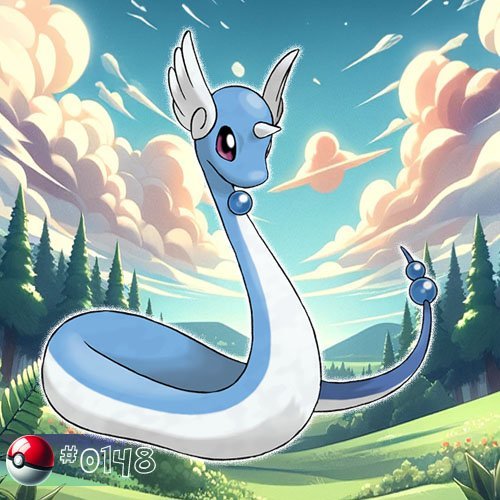Dragonair
Dragonair is a Dragon-type Pokémon characterized by its elegant and serpentine appearance. Dragonair is revered for its beauty and grace, often depicted in folklore and legends as a symbol of purity and power.

| National Pokedex No: 0148 |
| Type: |
| Category: Dragon Pokémon |
| Height: 4.0 m (13′01″) |
| Weight: 16.5 kg (36.4 lbs) |
| Gender: 50% ♂, 50% ♀ |
| Abilities/Hidden abilities: Shed Skin/Marvel Scale |
Biology
Physical Characteristics
Dragonair is a Pokémon characterized by its elegant and serpentine appearance. Dragonair is a medium-sized Pokémon, typically measuring around 13 feet (4 meters) in length. Despite its length, it is surprisingly lightweight due to its serpentine body structure. Here are its physical characteristics in detail.
Dragonair has a long, serpent-like body that is sleek and streamlined, enabling it to move gracefully through the air and water. Its body is predominantly light blue in color. Unlike its pre-evolution, Dratini, Dragonair lacks visible wings. Instead, it is believed to be capable of flying using its mystical powers and the tufts of cloud-like structures that adorn its body.
Dragonair possesses large, expressive eyes that are typically a deep shade of blue. Its eyes give off a sense of wisdom and serenity. Dragonair has two horn-like structures on its head, which resemble antennae or ear-like protrusions. These horns are often depicted as being adorned with small jewels or orbs. Dragonair has two long, thin whisker-like appendages on its face, extending from either side of its snout. These whiskers add to its majestic appearance.
Dragonair’s tail is long and elegant, often depicted as being longer than its body. The tail ends in a distinct, orb-like structure, which resembles a crystal or gemstone. While Dragonair’s body appears smooth, it is covered in fine scales that give it a shimmering appearance, especially when it moves or when light reflects off its body.
Overall, Dragonair’s physical characteristics embody grace, beauty, and mystical elegance, making it one of the most captivating Pokémon in the world of Pokémon.
Behaviour
Dragonair, with its serene and majestic demeanor, exhibits a variety of behaviors that reflect its graceful nature and mystical essence.
Dragonair is known for its tranquil and composed disposition. It rarely displays aggression unless provoked or threatened. Even in the face of danger, it maintains its poise and rarely resorts to violence. Dragonair emits a soothing and mystical aura that captivates those around it. Its presence exudes a sense of calmness and wonder, drawing admirers to observe its beauty.
Dragonair moves with fluidity and grace, whether gliding through the air or swimming in bodies of water. Its movements are mesmerizing to behold, often likened to a dance or ballet performance. Despite lacking visible wings, Dragonair is believed to be capable of flight using its innate mystical powers. It soars gracefully through the sky, often accompanied by swirling clouds or gentle breezes.
While generally peaceful, Dragonair can exhibit protective behavior towards its territory or companions. It will fiercely defend itself or its allies if they are threatened, using its mystical abilities to deter potential threats. While Dragonair primarily communicates through non-verbal cues and body language, it is believed to possess telepathic abilities that allow it to communicate with other Pokémon and humans on a deeper, more intuitive level.
Dragonair is known to display curiosity towards its surroundings, often exploring new environments with a sense of wonder and intrigue. It may investigate unfamiliar objects or creatures with gentle curiosity. Dragonair shares a deep affinity with the natural world, often found near bodies of water or in serene, natural habitats. It may engage in rituals or behaviors that demonstrate its reverence for nature.
Dragonair’s behavior reflects its status as a mystical and revered Pokémon, embodying qualities of grace, tranquility, and spiritual wisdom. Its presence brings a sense of harmony to its surroundings, inspiring awe and admiration in those fortunate enough to encounter it.
Evolution
The evolution of Dragonair is a fascinating process that transforms it from a graceful and elegant Pokémon into a powerful and majestic creature. Here’s a detailed overview of Dragonair’s evolution.
Dragonair begins its life cycle as a Dratini, a small and serpentine Pokémon often found near bodies of water. Dratini hatches from an egg, emerging as a tiny and relatively defenseless creature. As Dratini grows and matures, it undergoes significant physical and emotional development. Through training, bonding with its Trainer, and experiencing various adventures, Dratini gains strength, confidence, and wisdom.
Dragonair evolves from Dratini when certain conditions are met. Typically, Dratini evolves into Dragonair after reaching a certain level of experience (level 30), often through battles and training. Alternatively, it may evolve when exposed to a specific item like a Dragon Scale or when it achieves a milestone in its journey. The evolution process triggers a remarkable transformation in Dratini’s appearance and abilities. It grows larger in size, its serpentine body becomes more elongated and streamlined, and its scales take on a vibrant and iridescent hue. Dragonair’s graceful movements and serene demeanor distinguish it as a symbol of elegance and mystique.
Upon evolving into Dragonair, this Pokémon gains access to a broader range of abilities and powers. Its innate mystical energy, already potent in its Dratini form, becomes more refined and controlled, allowing Dragonair to manipulate the elements and harness elemental attacks such as Dragon Breath and Dragon Pulse.
As Dragonair continues to grow and develop, it prepares for its ultimate evolution into Dragonite, the final stage of its evolutionary line. This evolution typically occurs later in its life cycle, after Dragonair has amassed significant experience, strength, and wisdom (level 55).
The evolution of Dragonair represents a transformative journey marked by growth, maturity, and the realization of its full potential. From its humble beginnings as a Dratini to its majestic form as Dragonair, this Pokémon undergoes profound changes that reflect its inner strength and resilience.
Appearances
Anime Main Appearances
Ash’s Dragonair
In “A Test in Paradise!”, a wild Dragonair inhabiting Dragonite Island alongside three others underwent evolution into a Dragonite. Having established a bond with it earlier, Ash subsequently captured it.
Clair’s Dragonair
In “Beauty is Skin Deep” Clair’s Dratini evolved into a Dragonair while Clair protected it from Team Rocket. Later, in “Better Eight Than Never” Clair deployed Dragonair as her final Pokémon in her Gym battle against Ash.
Other appearences include episodes:
- Banned episode EP035 (Dragonair debuted as a Dratini under the care of Safari Zone warden Kaiser. Over 30 years, it evolved into Dragonair, with a child Dratini now in tow.)
- “On Olden Pond” (Dragonair residing in a lake thwarted plans for a luxury resort when it saved Mr. Saridakis, who then canceled the development.)
- “Master Class Choices!” (Amelia showcased a Shiny Dragonair and an Espeon at the Fleurrh City Showcase, reaching the Freestyle Performance but losing to Serena.)
- “A Mission of Ultra Urgency!” (Lana utilized a Ride Dragonair as part of the Ultra Guardians.)
- “A Test in Paradise!” (This episode featured three Dragonite, one of which Ash would eventually catch.)
Anime Minor Appearances
Dragonair first appeared in the English dub in ”Pikachu’s Rescue Adventure”, briefly seen flying around a rainbow after a storm. In ”Dueling Heroes”, a Trainer in the Whirl Cup owned one. Team Rocket also fantasized about Dragonair in ”Imitation Confrontation”. Multiple Dragonair appeared in ”The Island Whisperer!”.
Manga Appearances
Ash & Pikachu
Dragonair owned by Clair, the Gym Leader of Blackthorn City’s Gym, appeared in ”The Dragonite’s Imperial Wrath”.
Pocket Monsters XY: The Legend of the Pokémon Dragon King
A Dragonair was seen in the first true chapter of this manga, LDK1.
Pokémon Adventures
Dragonair debuted in ”Long Live the Nidoking!” at Fuchsia City’s Safari Zone. It appeared with its Trainer in ”Just a Spearow Carrier” at the Indigo Plateau. Lance owns two Dragonair: one previously caught and the other stolen and brainwashed. Multiple Dragonair, along with Aerodactyl, comprise Lance’s Dragon-type army, first seen in ”Playing Horsea”.
Clair’s Dragonair featured in ”Debonaire Dragonair”, battling Ryu’s Seadra and winning. Later, it faced Suicune at ”Dragon’s Den” but was defeated. Dragonair was also part of the battle in Ilex Forest in ”The Last Battle XIII”. The Battle Factory rented one, stolen by Guile Hideout in ”Lemme at ‘Em, Lapras!”.
Pokémon Gotta Catch ‘Em All
In “Crystal Orb of Rainfall” Shu encounters Ryuko, a Dragonair in human form, aiding her in retrieving her lost blue orb. Subsequently, in GDZ66, Shu captures his own Dragonair.
Pokémon Pocket Monsters
Clair’s Dragonair featured in “The Ultimate Battle…?!”. In “The Final Battle!!”, Lance’s Dragonite recounts a fictitious encounter with a Dragonair. Additionally, in “Good-Bye, Pikachu?!”, a Dratini evolved into a Dragonair and later into a Dragonite during a battle with Giovanni’s Pokémon.
Game data
Stats
Location
| Game version | Location |
|---|---|
| Pokémon Red and Pokémon Blue | Evolve Dratini |
| Pokémon Yellow | Safari Zone |
| Pokémon Gold and Pokémon Silver | Route 45, Dragon's Den |
| Pokémon Crystal | Route 45, Dragon's Den |
| Pokémon Ruby and Pokémon Sapphire | Trade |
| Pokémon FireRed and Pokémon LeafGreen | Safari Zone |
| Pokémon Emerald | Trade |
| Pokémon Colosseum | Trade |
| Pokémon XD | Trade |
| Pokémon Diamond and Pokémon Pearl | Mt. Coronet |
| Pokémon Platinum | Mt. Coronet |
| Pokémon HeartGold and Pokémon SoulSilver | Dragon's Den, Safari Zone |
| Pokémon Black and Pokémon White | Dragonspiral Tower |
| Pokémon Black 2 and Pokémon White 2 | Dragonspiral Tower |
| Pokémon X and Pokémon Y | Route 21, Safari Zone |
| Pokémon Omega Rubya and Pokémon Alpha Sapphire | Trade |
| Pokémon Sun and Pokémon Moon | Poni Gauntlet, Poni Meadow, Vast Poni Canyon |
| Pokémon Ultra Sun and Pokémon Ultra Moon | Poni Gauntlet, Poni Meadow |
| Pokémon: Let's Go, Pikachu! and Pokémon: Let's Go, Eevee! | Route 10 |
| Pokémon Sword and Pokémon Shield | Trade |
| Pokémon Brilliant Diamond and Pokémon Shining Pearl | Mt. Coronet |
| Legends Arceus | Unobtainable |
| Pokémon Scarlet and Pokémon Violet | Casseroya Lake |
Dragonair's origin name
English: In English, the name “Dragonair” is a combination of “dragon” and “air”, likely referencing its serpent-like appearance and its association with mystical powers and the sky.
Japanese: In Japanese, Dragonair is known as “ハクリュー” (Hakuryu), which is derived from “白龍” (hakuryū), meaning “white dragon”. This name reflects Dragonair’s serpentine form and its association with purity and elegance.
French: In French, Dragonair is known as “Draco”, which is a direct reference to dragons and their association with mythical powers and serpentine creatures.
German: In German, Dragonair is named “Dragonir”, a combination of “dragon” and “Nir” (a shortened form of “Nixe”, meaning “nymph” or “water spirit”), suggesting its mystical and aquatic attributes.
Spanish: In Spanish, Dragonair is called “Dragonir”, which closely resembles its German name and retains the same meaning of a dragon-like creature with mystical properties.
Italian: In Italian, Dragonair retains its English name “Dragonair”, emphasizing its connection to dragons and the mystical aura surrounding this Pokémon.
Korean: In Korean, Dragonair is known as “하크로우” (Hakeurou), which is a transliteration of its Japanese name “ハクリュー” (Hakuryu). The Korean name reflects Dragonair’s serpentine appearance and its association with the dragon motif.
Chinese (Simplified): In Simplified Chinese, Dragonair is written as “哈克龙” (Hākèlóng), with “哈克” (Hākè) phonetically representing the sound of “dragon” and “龙” (lóng) meaning “dragon”.
Chinese (Traditional): In Traditional Chinese, Dragonair is written as “哈克龍” (Hākèlóng), using the same characters as in Simplified Chinese but with the traditional character forms.
These names reflect Dragonair’s serpentine appearance, mystical abilities, and association with dragons and mythical creatures in various cultures and languages.




